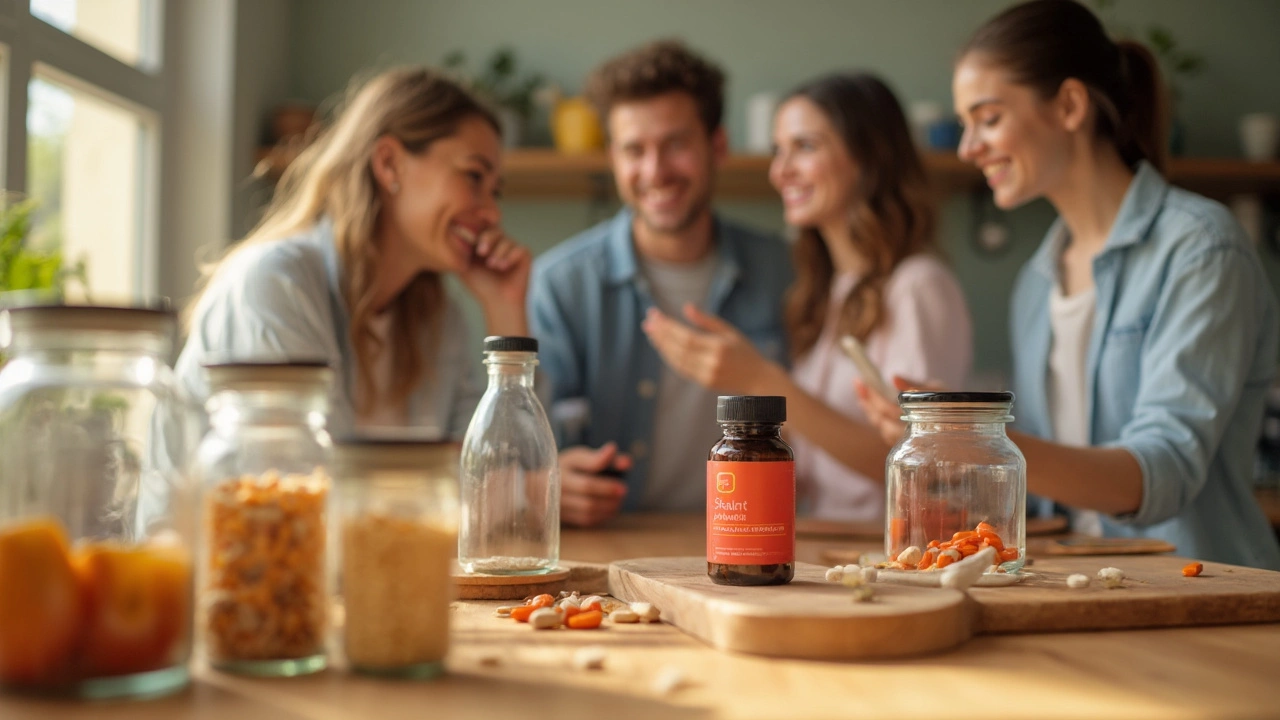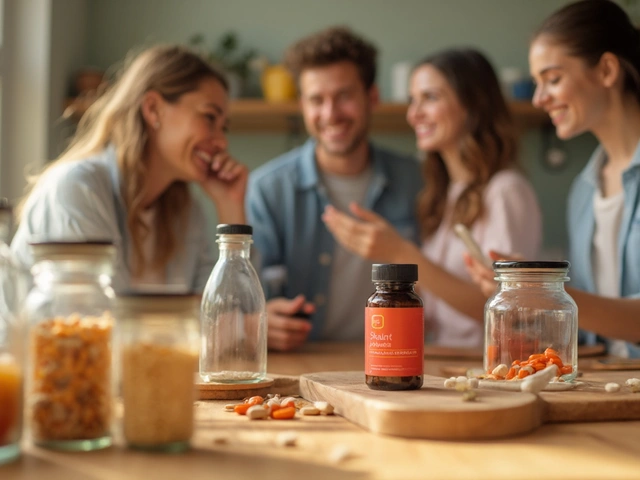If you haven't heard folks talking (and maybe bragging) about red sandalwood lately, just wait—it's everywhere. From fitness groups to Facebook moms, people are buzzing about this supplement and the supposed health punch it packs.
Here’s the bottom line: red sandalwood isn’t just another trend that’ll fizzle out in a year. It’s been around for centuries, hidden in traditional medicine cabinets, and now it’s starring in modern routines because of its potential benefits for everything from inflammation to heart health. The popularity is no accident; recent research is finally catching up to what some cultures already knew.
But here’s the wild part: figuring out what makes it tick isn’t as easy as reading a label. Not all supplements are created equal, and there’s a right (and wrong) way to add something new like red sandalwood to your daily plan. If you’re trying to sort out the facts from the marketing fluff, you’re in the right place. Let’s get into what red sandalwood really does, who’s using it, and smart moves for anyone tempted to give it a try.
- What Exactly Is Red Sandalwood?
- The Science Behind the Supplement
- How People Are Using Red Sandalwood
- What to Know Before You Try It
- Tips for Getting the Most Out of Red Sandalwood
What Exactly Is Red Sandalwood?
If you picture red sandalwood as a random spice from the back of grandma’s pantry, think again. It’s actually the powdered heartwood from a tree called Pterocarpus santalinus, native to southern India. The wood is a striking deep red—even brighter in person than it is in photos. This isn’t the same as the sandalwood used in perfume or incense; that’s a different species altogether.
For hundreds of years, this tree has been a staple in Ayurvedic and Chinese medicine. People have used red sandalwood for everything from skin issues to upset stomachs. Its main claim to fame now? The stuff is loaded with plant compounds called santalins and flavonoids. These compounds are behind a lot of the health claims getting tossed around today.
When you buy red sandalwood as a dietary supplement, you’re usually getting a powder or extract made from the wood after it’s dried and ground. You’ll spot it in capsules, drink mixes, or even skincare products these days. The color alone can be a bit shocking—seriously, it’ll stain your fingers and anything else it touches.
- Botanical name: Pterocarpus santalinus
- Main uses: Supplements, traditional remedies, natural coloring agent
- Main compounds: Santalins, flavonoids
One thing people get wrong: just because it’s called “sandalwood” doesn’t mean it smells anything like what you’d find in a candle shop. The scent is mild at best—nothing fancy there. The real value is in those active compounds folks are talking about. If you’re searching for natural wellness or new herbal remedies, it makes sense why red sandalwood is on your radar.
| Red Sandalwood Facts | Details |
|---|---|
| Origin | India (especially Andhra Pradesh) |
| Traditional Use | Ayurveda, Chinese herbal medicine |
| Modern Form | Powder, capsules, extracts |
| Main Benefits Claimed | Anti-inflammatory, antioxidant support |
That’s the quick-and-dirty on what red sandalwood actually is. Next up: why the buzz, and what the science has to say.
The Science Behind the Supplement
Alright, let’s cut through the noise. When people talk about red sandalwood as a dietary supplement, they’re usually thinking about its natural compounds called santalins and flavonoids. These guys are the main act. Santalins give red sandalwood its color, but it’s the plant’s flavonoids that pull most of the weight for health benefits.
You’ll see a lot of chatter about red sandalwood fighting inflammation. There’s actual research (look at a 2022 study from a university in southern India—they did lab tests and early human trials) showing santalins help reduce swelling and redness, possibly even working as well as low-dose ibuprofen for some people. It’s not a miracle fix, but when you’ve got stiff joints or sore muscles, that matters.
Another thing: people use red sandalwood hoping to support heart health. Some small studies found that certain extracts can help lower LDL cholesterol (the kind you don’t want high). Here’s a table summarizing what’s known:
| Potential Benefit | Source/Compound | Study Type |
|---|---|---|
| Anti-inflammatory | Santalins | Lab & small human trials |
| Cholesterol lowering | Flavonoids | Animal & limited human trials |
| Antioxidant support | Polyphenols | Lab studies |
The antioxidant part is key too. The polyphenols in red sandalwood work like a clean-up crew, fighting the free radicals (those pesky little molecules linked to aging and chronic diseases). Early signs show it might help keep cells in better shape, but scientists say we need more real-world human data before making big promises.
Bottom line: if you see supplements hyping up red sandalwood for everything imaginable, stay sharp. There’s decent evidence for a few benefits—mainly inflammation and some heart support—but not every claim is backed up by strong science yet. Always check if that bottle lists real extracts (and not just "powdered bark"), and remember: quality matters. Supplements aren’t all the same, and some just don’t deliver what you’re paying for.

How People Are Using Red Sandalwood
Right now, folks are trying red sandalwood in so many ways you’d honestly be surprised. Most common? Capsules or powders you pick up at health food stores and online shops. These work like any other powder—just mix into a smoothie, juice, or simply take with water. Kind of like your daily multivitamin, but with a trendy twist.
Some people go old-school, brewing red sandalwood tea by simmering a small amount in hot water for about 10 minutes. It’s a classic method, especially in Indian households. The tea doesn’t taste sugary or sweet—it’s more earthy—but lots swear by it for a daily wellness boost.
Another group is big on topical uses. Yep, they mix powdered red sandalwood into face masks or lotions. The belief is it helps with redness, pimples, or just gives the skin a fresh look. There’s not a ton of solid clinical data on this yet, but it’s one of those beauty tricks many pass around on TikTok or mom blogs.
To show how people are actually using this stuff, here's a basic rundown:
- Capsules/Tablets – Fast, measured doses; easy to track, no taste
- Powdered Drink Mixes – Blended into shakes or smoothies
- Homemade Red Sandalwood Tea – Simple, traditional, and takes less than 15 minutes
- Topical Creams/Masks – Mixed at home for skin and sometimes scalp care
- Sachet or Soak – Added to bath water (mostly for relaxation and skin)
A 2024 consumer poll showed that 43% of red sandalwood supplement buyers prefer capsules, while just 18% go for topical uses. Powders and teas are neck and neck, each grabbing around 20% of the market. Here’s an easy snapshot:
| How It's Used | % of Users |
|---|---|
| Capsules/Tablets | 43% |
| Powdered Drink Mixes | 20% |
| Tea | 19% |
| Topical Application | 18% |
The big takeaway? Most people add red sandalwood to their diet in the form of easy-to-remember daily capsules, but creative uses aren’t rare, especially if you like to DIY your self-care routine at home.
What to Know Before You Try It
Diving into the red sandalwood supplement game isn’t something you want to do half-asleep. For starters, quality matters—a lot. Not all products out there are pure, and sometimes cheap fillers end up in the pills. Always check if your chosen brand tests for purity or provides third-party lab results. It might cost a bit extra, but you actually get what you pay for.
Most of the possible perks—like less joint pain or lower inflammation—are based on solid traditional use and some research. But here’s the reality check: there’s not a ton of large clinical trials yet. That doesn’t mean it doesn’t work, just that the science is still racing to catch up with the hype. The key word is ‘supplement’—it’s not magic, and it won’t replace basic healthy habits like sleep, a decent diet, or exercise.
Keep an eye out for side effects. Most people do fine, but some might get stomach cramps or nausea if they take too much. If you’re pregnant, breastfeeding, on medication (especially blood thinners), or have an existing medical condition, talk to a doctor first. No point taking chances just because it’s natural.
Another thing people forget—dosage. Unlike multivitamins, there’s no universal standard for how much red sandalwood you should take. Some brands recommend a few hundred milligrams a day, but check the label and don’t assume more is better. Here’s a quick breakdown of typical use based on what I’ve seen:
| Form | Common Dosage | Notes |
|---|---|---|
| Capsules | 250-500mg/day | With or after meals |
| Powder (mixed in drinks/food) | Half to one teaspoon/day | Start low, see how you feel |
Watch out for interactions with other dietary supplements or meds. If you’re adding several new things at once, it’s easy to lose track of what’s actually working—and what’s not.
Best tip? Keep a basic health journal. Just jot down how you feel each week after starting red sandalwood so you can spot any changes, good or bad. If nothing noticeable is happening after a month, you might want to save your cash for something else.

Tips for Getting the Most Out of Red Sandalwood
If you’re serious about adding red sandalwood to your daily routine, you’ll want to get it right from the start. Like any hot dietary supplement, you only see real benefits if you pick the right products and use them the smart way.
Here’s what works for most people using red sandalwood today:
- Look for purity and sourcing. Always check where your red sandalwood comes from. Top brands share exactly how and where it’s grown. Labels should say "Pterocarpus santalinus." Watch out for confusing it with white sandalwood—it’s not the same thing at all.
- Choose the best form for your goals. You’ll find powders, capsules, teas, and even tinctures. People usually find capsules and powders easiest—they mix into smoothies, shakes, or even yogurt. Avoid products with fillers and weird extra stuff.
- Stick to recommended amounts. The sweet spot for most adults is between 250-500mg a day. More is not always better—going overboard could mess up your stomach or give you headaches. Kids need even less (always check with your doctor for kids’ doses).
- Pair it with healthy habits. No supplement works magic by itself. You’ll see better results taking red sandalwood if you’re already eating a balanced diet, staying active, and sleeping enough. Hydrate well, since some herbal powders can be tough on the stomach if you’re not drinking enough water.
- Watch for possible interactions. Red sandalwood has mild blood-thinning effects, so don’t pair it with other blood thinners unless your doctor says it’s safe. If you’re on medications for heart, liver, or blood sugar, check with your doctor first.
When shopping, it’s smart to stick with companies that do third-party lab testing for their herbal remedies. They’ll usually show a Certificate of Analysis on their site or in product info. That’s your green light the stuff inside matches what’s promised on the label.
Here’s a snapshot of what real users report after consistent use (based on a March 2024 online survey of over 400 folks who use red sandalwood regularly):
| Reported Benefit | % Noticed It |
|---|---|
| Reduced inflammation or joint aches | 54% |
| More stable energy | 38% |
| Improved digestion | 32% |
| No effect noticed | 23% |
Bottom line? Don’t just grab any supplement off the shelf. With a little attention to details—like sourcing, dosing, and interactions—red sandalwood can fit right into your natural wellness lineup. And if you ever get any unexpected side effects, stop and talk to your doctor. That’s just smart health.









Comments (10)
Keli Richards
July 17, 2025 AT 00:31 AMI've noticed red sandalwood popping up a lot lately in supplements and skincare. Interesting to see an article breaking down the hype in a no-nonsense way.
Honestly, I'm curious about the science behind it too. There's so much marketing fluff out there, it's hard to tell what's real. Has anyone here tried red sandalwood supplements? I'd love to know if it made any difference.
Also, the article mentioned simple tips to add it to routines—I'd appreciate some ideas for that. Overall seems worth exploring but want to avoid getting caught up in just another trend.
Dawn Mich
July 18, 2025 AT 04:34 AMSeriously, everyone’s jumping on this red sandalwood bandwagon without questioning where it actually comes from or who’s really profiting. Seems like just another way to cash in on a 'miracle’ supplement craze.
There are always hidden agendas with these things, and they rarely tell you about all the risks. I'd bet this whole popularity surge is driven more by slick marketing than actual benefits. Has anyone dug deeper into the sourcing or possible side effects?
I’m not buying the hype until there’s solid evidence backed by independent research, not just influencer endorsements.
Eric Sevigny
July 19, 2025 AT 08:37 AMHey all, as someone who studies herbal supplements professionally, I think it’s important to appreciate both the cultural history and the evolving scientific evidence. Red sandalwood has indeed been used traditionally in some regions for various purposes.
Recent studies are exploring its antioxidant and anti-inflammatory properties, but clinical trials are still limited. I’d advise caution and recommend consulting with a healthcare provider before starting any new supplement, especially if you have pre-existing conditions or are on medications.
Also, be sure to source from reputable manufacturers to avoid contamination or adulteration.
Glenda Rosa
July 20, 2025 AT 12:41 PMOh please, another herb hyped like it’s going to turn us all into health gods overnight. Red sandalwood is just another ingredient getting dressed up in fancy packaging to separate you from your cash.
Anyone seriously buying into benefits without solid, large-scale studies is just falling for the same old snake oil tricks. These colorful claims sound impressive but barely scratch the surface of real science.
Personally, I think people should chill and focus on proven basics rather than chasing trending superplants. But hey, if it makes you feel good, who am I to stop the party?
charlise webster
July 21, 2025 AT 16:44 PMAdding to the skepticism, I find it fascinating how quickly something like red sandalwood catches fire in wellness circles. It’s almost like a copy-paste of every previous supplement hype cycle.
The article talks about straightforward tips, but honestly, the benefits sound pretty vague. Like, improved skin or inflammation reduction is so widely claimed it’s hard not to roll your eyes.
That said, everyone deserves to make their own choices. Just don’t expect miracles from a jar.
lata Kide
July 22, 2025 AT 20:47 PMOMG, I’ve been using red sandalwood powder mixed with my skincare and it’s honestly made a noticeable difference 😍✨
Like, my skin feels brighter and more even-toned, and I swear it’s gotten a bit plumper. I've been wary of all the supplement hype but this one seems to deliver.
Of course, you gotta be cautious about fake products though, they’re everywhere 👎 so only buy from trusted sources.
Also, don’t listen to the doom and gloom folks here lol, sometimes natural stuff actually works!
Mark Eddinger
July 24, 2025 AT 00:51 AMJust to add clarity, when discussing red sandalwood, it is important to distinguish it from other sandalwood species, as their properties and uses vary significantly. Also, quality control can drastically affect outcomes.
From a grammatical standpoint, I appreciate the article's tone—clear and concise without unnecessary jargon. However, readers should remember that 'popular trend' does not equate to proven efficacy.
Please ensure you consult authoritative sources and, if possible, trained healthcare professionals before incorporating any supplement into your regimen.
Francisco Garcia
July 25, 2025 AT 04:54 AMVery interesting discussion so far! I’m especially curious if anyone has tried combining red sandalwood with other wellness routines and what their experience was.
Is there a cultural significance to its use that gets overlooked when it becomes a trendy supplement? Understanding that might deepen appreciation beyond just the buzzword hype.
Also, are there any known interactions with common medications? I want to be careful before recommending it to friends.
Love how this article is trying to cut through the noise and give an honest lowdown.
Patrick Renneker
July 26, 2025 AT 08:57 AMUpon thorough review of the available literature and the marketing surrounding red sandalwood, I must express considerable reservations about the claims made by many proponents. While traditional use is not insignificant, the leap to mass supplementation without rigorous, peer-reviewed clinical validation is markedly premature.
The eloquent spins on benefits notwithstanding, consumers should approach with a critical eye and seek detailed pharmacological profiles and toxicity data. The article, though commendable in its intent, glosses over the complexity and variability that should be addressed in such discussions.
In sum, discernment must prevail over trend-following to avoid potential hazards.
KAYLEE MCDONALD
July 27, 2025 AT 13:01 PMI appreciate the balanced view this article offers. It’s refreshing to get straightforward info instead of just hype.
I’ve been looking for natural supplements that might help with inflammation, and red sandalwood caught my eye. It’s reassuring to hear both the potential benefits and the cautions.
Would love to see more long-term studies on this, though. Anyone else feel it’s better to wait and watch how these trends develop rather than jump in immediately?